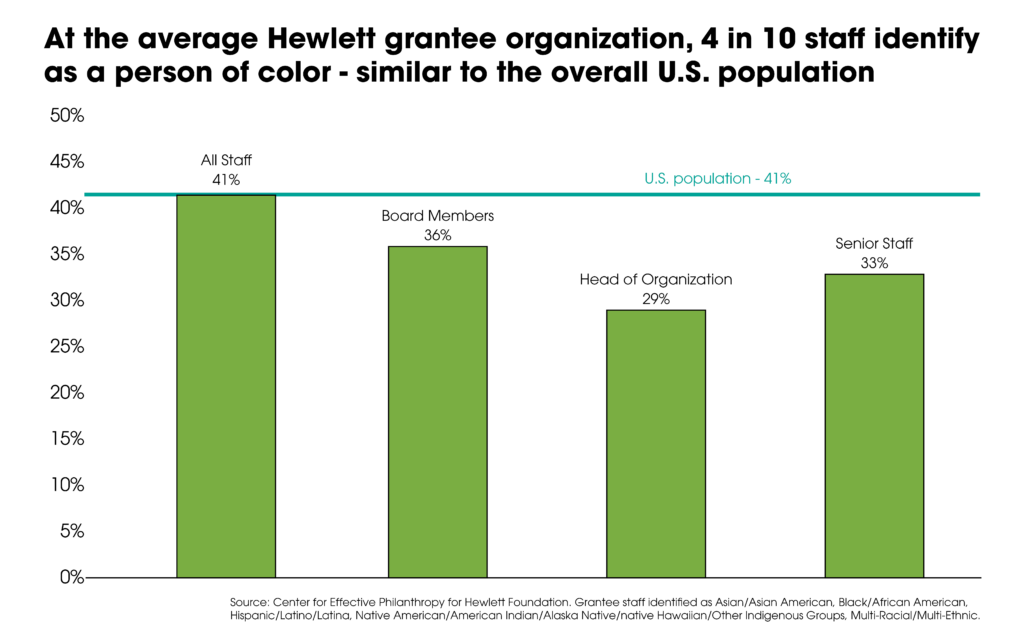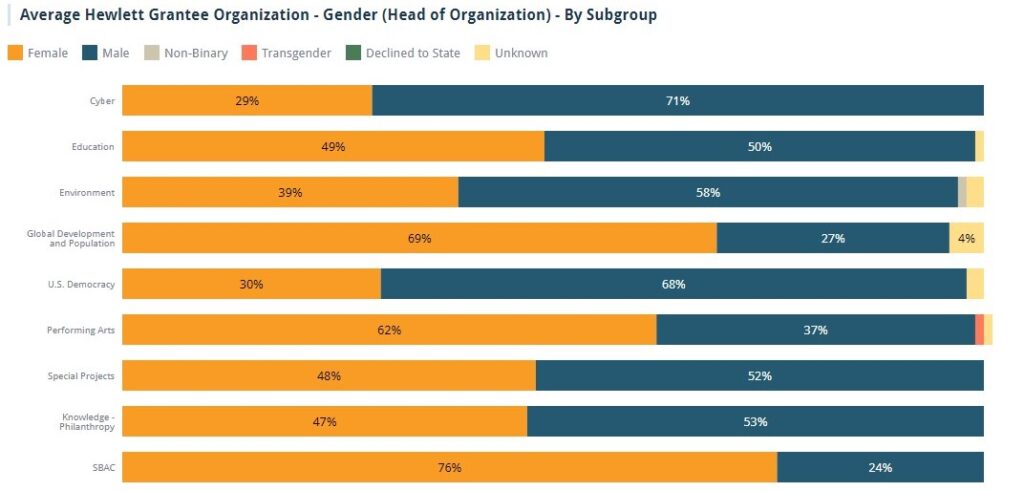This post originally appeared on the Hewlett Foundation blog. It is reposted here with permission.
The Hewlett Foundation began collecting information about the demographic makeup of its grantees in 2018 as part of our ongoing commitment to diversity, equity, and inclusion. Just as we collect and publish the demographics of our staff and board, we view the demographic data of our grantees as a critical input to help us understand who we are partnering with, and to inform and improve our practices for finding partners.
The purpose of collecting this data is not to grade specific organizations — in fact, we examine the data in aggregate fashion, anonymized so no program officer gets the data of any individual arts organization, think tank, advocacy group, or other grantee. That’s because our goal is to improve our own work: to know if we are supporting an inclusive and diverse set of organizations, and identify where we need to correct gaps and deficiencies or root out implicit biases in our selection processes. Aggregate information about the racial, ethnic, and gender makeup of our grantees — including their staff, leadership, and board — helps us better interrogate how we ourselves are working to advance diversity, equity, and inclusion.
About the research | What we’re learning | What we’re doing
About the research
We began with U.S. organizations that we support, because demographic categories and social concerns vary in other geographies where we work, and we wanted to learn more about how to collect and use this data before tackling that additional complexity. And we excluded our grants to universities because we were frequently unable to reliably track demographics at the relevant unit level (a center versus a program versus a school versus the university as a whole). Even thus limited, our initial foray into collecting the data produced incomplete results, with lower-than-expected response rates, and led us to some process improvements that would support our learning while minimizing the burden on our grantees.
Our latest report, based on data we collected in 2019 and analyzed in 2020, represents 68% of our active U.S. grantees. While that’s a solid place to start, there are important gaps in the data. In addition to excluding universities and non-U.S. grantees, the survey asked only about race, ethnicity, and gender identity, rather than the full sweep of demographic traits we know are meaningful. As we continue learning and improving this work, we anticipate expanding the scope of our research to address these limitations.
Knowing the demographics of our grantees’ staff and leadership grew in importance this past year, as our organization, rocked back on its heels by the events of last summer, went through a period of intense reflection. Having made new commitments to more directly address racial justice, including plans to launch a 10-year, $150 million racial justice initiative, we know it’s critically important to develop a deeper understanding of how systemic racism affects the various fields in which we work, and how it intersects with other aspects of identity, including class, gender, and sexual orientation. Gender equity, in particular, remains a key priority of the foundation, which has from its founding provided support to organizations working to advance reproductive health and rights. In recent years, we have broadened that work to embrace women’s economic empowerment.
We are grateful to our grantees for taking the time to participate and to our partners at the Center for Effective Philanthropy (CEP), which for years has supported the philanthropic field in gathering and using data to inform and support learning. As part of this process, we have invested in a data platform, developed by CEP, that can be re-used and customized by other funders — something we hope to encourage by making our own data publicly available so funders can see the utility and quality of what CEP created. [Learn more.]
Each of our program teams spent a great deal of time learning about and from these data, to inform our work going forward, including various actions (described below) that we are undertaking in our efforts around diversity, equity, and inclusion. Moreover, we will continue to collect and update the data on an ongoing basis, enabling us to track progress and adapt our efforts as we learn.
What we’re learning from the data
According to the most recent data, 41 percent of the staff of our average grantee organization identify as Black, Indigenous, or with another community of color—in line with the overall U.S. population (41 percent, according to 2019 U.S. Census). Those numbers drop somewhat in leadership ranks: 36 percent of board members in the typical grantee organization identify as people of color, compared with 29 percent of heads of organizations, and 33 percent of senior staff.

In terms of gender, 62 percent of staff in the typical organization identify as female, significantly greater than the overall U.S. population (51 percent); a third identify as male, while 1 percent identify as non-binary and 1 percent as transgender. The proportion of women is similar among senior staff (63 percent), but it drops to slightly greater than half when it comes to heads of organizations (53 percent), and slightly less than half among boards (47 percent).
Digging deeper into this top-level data, we found greater diversity among grantees surveyed in 2019 than those surveyed in 2018, but also a great deal of variation across different dimensions, such as grantee organizations of different sizes or in different program areas. There are too many of these to discuss here, but they can be explored on the data platform, which we are making publicly available.
Among the key findings:
- Across the foundation’s grantee organizations, there was an increase in diversity of race and ethnicity between 2018 and 2019, including a six-point increase in organizations led by people of color. However, there are important differences by budget: the larger the organization’s annual operating budget, the more likely its leadership is to be white and male

- Across the foundation’s U.S. grantee pool, staff who identify as Black or African American are represented in roughly the same proportion as in the overall population (12 percent of the typical grantee’s staff, compared with 13 percent of the overall U.S. population), while staff who identify as Asian or Asian-American staff are somewhat over-represented (11 percent, compared with 6 percent in the overall U.S. population) and staff who identify as Hispanic, Latino or Latina are somewhat under-represented (11 percent again, compared with 18 percent in the overall population).
- While the typical grantee’s staff tilted female in every program, the likelihood of a woman leading a grantee organization varied widely depending on the program — from a low of 29 percent and 30 percent in our Cyber Initiative and U.S. Democracy Program, respectively, to a high of 69 percent and 76 percent in Global Development and Population and Serving Bay Area Communities programs.

These are just a few illustrative findings, suggestive of how revealing and useful it can be to look at this type of data. The CEP platform allows much more to be examined, yielding interesting and challenging differences across many dimensions to be examined.
… And what we’re doing next
These data are one part of a deeper examination that the foundation has been engaged in for a number of years — an effort that grew more urgent after the racial reckoning in 2020, on top of a pandemic that laid bare the persistent inequities in the U.S. and global societies. In addition to scrutinizing these data, the foundation has supported staff in one-on-one coaching and team-wide learning sessions focused on racial justice, commissioned additional data-driven research that examines demographics in communities served and in specific fields of work, and begun identifying and sharing ways to identify implicit bias and develop more inclusive grant practices.
It is important to note that, as a matter of legal and policy judgment, the foundation does not set specific race- or gender-based targets for either its own staff or for grantees. And while we cite the U.S. population as a comparison benchmark above, we know there are no “magic numbers” and that entrenched patterns of discrimination require constant effort and vigilance to uncover biases, improve strategies and processes, and be more inclusive.
These data provide a baseline and foundation for ongoing measurement and reflection to inform and support our learning, culture, and actions. We have seen how fruitful that approach can be from our efforts to address our own organization’s demographics, which is where Hewlett’s work on diversity, equity, and inclusion began eight years ago: In 2012, the foundation’s staff was 69 percent white; today that figure is 49 percent, the result of greater awareness and more inclusive recruitment and retention practices.
We recognize, too, that numbers tell only part of the story. The insights and experience of board members, staff at every level, grantees, and the communities in which they work are critically important, and we must take a holistic approach — one that is thoughtful, authentic, and substantive — to meet our aspirations.
Here are some of the concrete ways in which we are acting on what we have learned:
Heeding the demands of equity as new strategies are developed. Questions related to diversity, equity, and inclusion are being asked and more intentionally incorporated into Hewlett’s outcome-focused philanthropy approach. For example, the grantee portfolio of our Environment Program’s Wildfire Strategy, launched in late 2020, has been built from the outset with DEI in mind — focusing, in particular, on the leadership and knowledge of tribes, as well as on organizations dedicated to diverse and inclusive coalition-building. Meanwhile, program staff in our Global Development & Population Program, which includes some of our longest-standing strategies, have put equity at the core of their ongoing strategy refreshes — taking a close look, in particular, at ways to shift power, support voices in Africa, and build more equitable partnerships. Similar work is underway in all of our programs, which are investigating how systemic racism shows up in their respective fields and looking for ways to address it in our grantmaking that will improve our capacity to achieve our goals and outcomes.
Commissioning data-driven research to guide practices in specific fields. While the demographic data provide one entry point, several of our programs are pursuing complementary research that can support greater understanding and more inclusive practices. Our Performing Arts Program, for example, participates with peer funders in related data coding projects specific to the arts sector and gathers county-level demographic data in the Bay Area to help guide how and where to build new relationships. Our Cyber Initiative is investing in efforts to better understand the demographics of the specific field it has been working to build at the nexus of national security and technology. Our Global Development & Population Program has been examining geographic patterns in funding — finding, for example, that just 20 percent of annual grant dollars were awarded to organizations based in Africa, Latin America, or Asia; with more intentional efforts, the program team raised that figure to 30 percent last year, and it has made continuing this shift central to its ongoing and future work.
Expanding our networks to connect with new potential grantees and building deeper relationships with grantees serving diverse communities. Our Education Program, which has among the most diverse grantee portfolios in the foundation, is working to continue that trend with hopes of seeing, in future demographic reports, greater diversity on gender identity, increased representation of men of color at all levels, and increases in women on grantee boards and senior staff, among other changes. Considering new ways to source and build relationships with new grantees is a key consideration. For our U.S. Democracy program, the results of our demographic data collection has led the team to widen what has been a primary focus on ideological and political diversity to include more attention to race, ethnicity, and gender in its relationship-building, learning, and networking.
Provide capacity-building DEI grants to individual organizations. In addition to diversifying networks and building new relationships, Hewlett has for the past several years been making DEI-focused organizational effectiveness grants to existing grantees in all our programs. We know that all organizations, no matter how long or deeply invested in DEI, have room to grow and require support for capacity-building and restorative work. Although program staff receive the foundation’s demographic data in aggregate, they are able to use these data to explore how capacity grants for individual organizations might best be deployed to help organizations address challenges and long-term DEI planning.
Evaluating and adjusting grant practices that can introduce bias. Our program, legal, and grantmaking operations staff are exploring ways to spot implicit or unseen biases and ensure that our grantmaking operations function equitably for current and potential grantees. Steps here include exploring efforts to simplify Hewlett’s grant application and reporting process, use more requests for proposals (RFPs) and letters of inquiry (LOIs), and provide financial assistance to facilitate compliance with Hewlett’s legal and financial requirements. As one example, having observed in its data that grant investments in organizations led by women and people of color tend to be smaller, our Education team is making changes in the program’s due diligence and risk tolerance, so as not to create unnecessary barriers to larger investments.
Supporting field-specific efforts to strengthen leadership and diversity, equity, and inclusion. Leadership matters, and these data help uncover gaps in specific fields and areas of work. Hewlett’s grantees with the smallest staffs are the most diverse, though, perhaps surprisingly, there is also considerable diversity — albeit to a lesser degree — at the largest organizations (400+ staff). In this U-shaped curve, diversity is most absent in organizations that have between 100-400 staff, meaning there are opportunities for program staff to help these organizations invest in, strengthen, and support diverse leadership. The data have also helped us identify specific fields in which to undertake more targeted action. Our Environment Program, for example, has made grants to support Green Leadership Trust, Latinos LEAD, and Race to the Board—complementary programs that work to create inclusive climate and conservation boards.
Considering the role of grantmaking intermediaries with respect to diversity, equity, and inclusion. Large philanthropies like ours rely on intermediaries — mission-driven groups that receive what amount to “block grants” that they re-grant in line with a shared strategy, especially to smaller organizations. Hewlett uses many such re-granting intermediaries, a product of our lean staff size relative to the scale of our grantmaking. To support, strengthen, and sustain diverse and inclusive grantee organizations, our programs have seeded and invested in intermediaries like the Climate and Clean Energy Equity Fund and the Hive Fund for Climate and Gender Justice. We are also evaluating whether and how well our other grantmaking intermediaries align with the Hewlett Foundation’s own commitments around diversity, equity, and inclusion, as well as those of the re-grantees. For example, our Global Development & Population Program has worked hard to ensure that re-granting organizations we work with in Africa provide general operating support and flow a substantial portion of the funds to many smaller advocacy organizations our grants are meant to empower.
Shifting our own language and supporting grantee-led efforts to amplify the voices of people of color and women. Our commitment to change extends beyond grant dollars and grant practices to reach other practices that may reflect or perpetuate inequities. We are exploring how to adopt asset-framing, championed by Trabian Shorters, in our language and materials, from strategy papers to grant applications, and updating our visual and text style guides to reflect more inclusive language. We are renaming our “Global Development & Population Program” to replace these outdated phrases, so entangled in the language of colonialism, with something that better reflects our values and the values of our grantees and partners. The foundation has also joined grantee-led efforts to promote more inclusive dialogue, as with a recent call to action from grantees of our Cyber Initiative seeking to change the makeup of voices in technology policy and national security events.
***
This is all just a start, and we know that much remains to be done. We will, undoubtedly, make missteps along the way. Describing ongoing efforts as a “journey” has perhaps become an overused cliché, but it’s apt here: we are working our way down a path in which we are learning with and from our peers, our partners, the communities in which we and they work, and the country at large. We do so with a good-faith commitment to do our best to do our part to dismantle embedded racism, bias, and discrimination in the fields in which we work and in our own culture and operations.
Explore the data, and view complete methodology and a summary of the findings from CEP.


